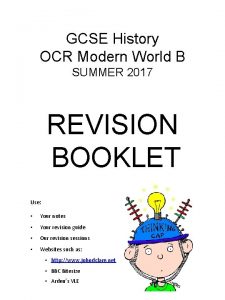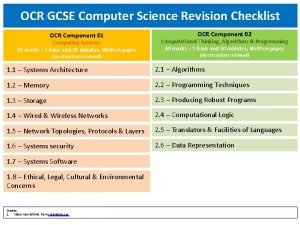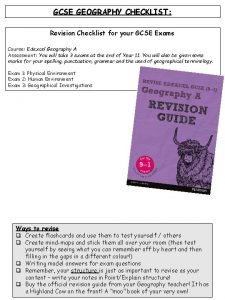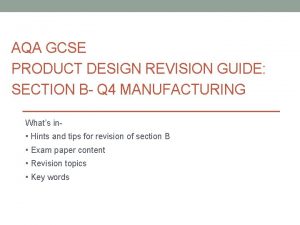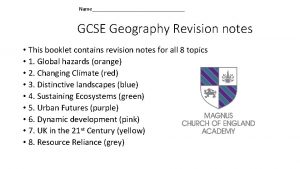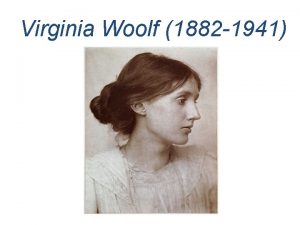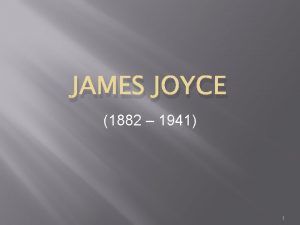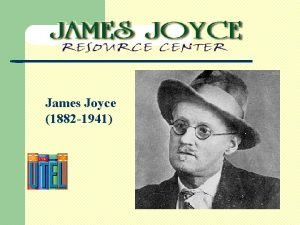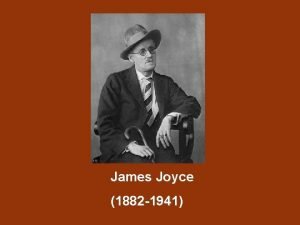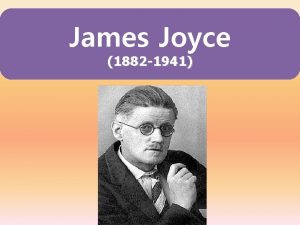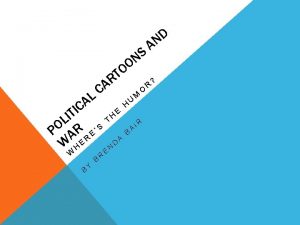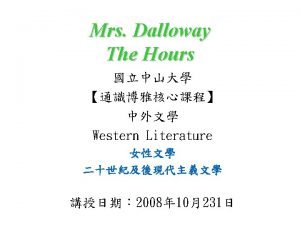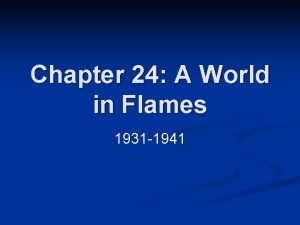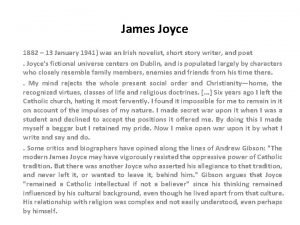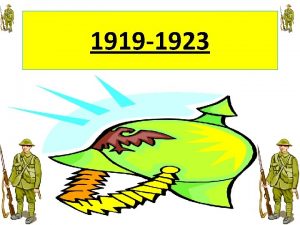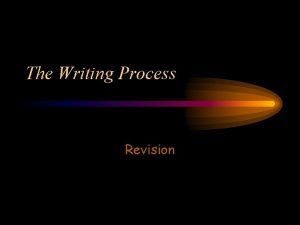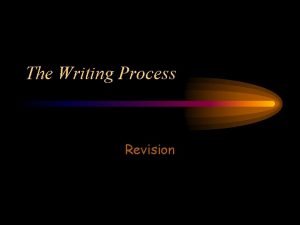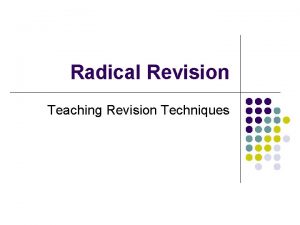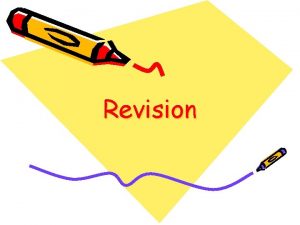GCSE REVISION America 1919 1941 America 1919 1941

















![The stock market hysteria reached its apex that year [1929]. . . Everyone was The stock market hysteria reached its apex that year [1929]. . . Everyone was](https://slidetodoc.com/presentation_image/49c9d1de719a7bf977ac0fa78fae5175/image-18.jpg)










- Slides: 28

GCSE REVISION America 1919 -1941

America 1919 -1941 – 4 key questions How far did the US economy boom in the 1920 s? 1. On what factors was the economic boom based? (6) The USA’s Wealth Rich in raw materials e. g. iron, coal and oil. A growing urban population of hardworking and ambitious immigrants. WW 1 had made the USA an economic world leader. New Industries Consumerism fuelled the boom with new electrical goods and new materials e. g. plastics. During the 1920 s industrial production grew by 50%. The growth of car industry and Ford’s assembly line model was the most significant. Rising wages and stable prices Real value incomes rose by around 25%. Prices of white goods dropped due the introduction of the assembly line to mass production.

On what factors was the economic boom based? continued Government policies Republican policies of laissez-faire, tariffs, low taxation and trusts helped to create an economic boom in 1920 s America Hire Purchase Credit was easily available. Hire purchase required a small deposit and further instalments. The popularity of mail order catalogues meant all Americans could become consumers. Weak Trade Unions There was great hostility towards Trade Unions from government and businesses. The car industry had none until the 1930 s. This kept wages low and hours long as profits rose. Henry Ford paid above the going rate!

Now try to come up with a mnemonic about the reasons for the boom in the 1920 s Mock 6 mark question: Why was there a boom in America during the 1920 s?

2. Why did some industries prosper while some did not? The growth of national wealth meant that people had money to spend on new white goods and luxuries. The construction industry boomed - new roads and skyscrapers changed the face of America. However, more traditional industries such as textiles, coal mining and shipbuilding declined. The textile industry was unable to compete with the southern factories where labour was cheaper. People now used electricity to heat their homes. The least profitable mines were forced to close.

3. l l l l Why did agriculture not share in the prosperity? The 1920 s were years of hardship. Having benefited from high prices during wartime, overproduction plagued the over successful farmer. Exporting the surplus was stopped by tariffs. Prices collapsed. Loans mounted up as farmers borrowed in the hope of better times. In 1920 one-third of the population was in farming families, that dropped to one-quarter as farmers lost their farms to the banks. Black sharecroppers faced the worst hardships.

4. l l l Did all Americans benefit from the boom? In 1929 60% of Americans lived below the poverty line. Many of these families were in rural areas. The boom had benefited the rich and the middle class. In 1929 one-third of all income was earned by 5% of the workforce. The boom did not really spread to the south where the majority of people were farmers. America’s black population suffered discrimination. Those that had moved North in search of work in the new factories were resented by whites workers as competition for jobs increased. Mock 10 mark question: Did all Americans benefit from the boom in the 1920 s?

How far did the US society change in the 1920 s? 1. What were the “Roaring Twenties”? The popular image of the USA in the 1920 s is of life as one long, crazy party, with jazz music playing on the radio, young fashionable women known as flappers wildly dancing the Charleston, large quantities of illegal alcohol being consumed, and everyone behaving in an scandalous a manner as possible. Consider the following topics: The movies Sport Music Radio Mock source question 7 marks: How useful is this source as evidence in telling us about life for Americans during the Roaring Twenties?

2. How widespread was intolerance in US society? Immigration In the 1920 s the land of immigrants started to close its doors to newcomers. This stirred up feelings of hatred and fear in the crowded slums of the cities. Red Scare The government feared immigrants may bring with them socialist ideas. Americans were concerned that communism could spread to the USA. Some were deported as part of round-ups. Sacco and Vanzetti case – Two Italian immigrants accused of robbery and murder were put on trial on little evidence. The trial was a farce and they were later executed more for their radical political views than the crime. Segregation and black people Black Americans were disadvantaged. In the South they were kept in a permanent state of poverty – restricted by the Jim Crow Laws. They were segregated from whites in every sphere of society. They had little or no political power in which to change things.

2. How widespread was intolerance in US society? cont. The Ku Klux Klan The Klan was formed after the Civil War. They struck terror in the black community with night-time raids, crosses and lynchings. The Klan led a campaign of terror throughout the 1920 s however, their membership fell when the Klan’s leader was convicted for the rape and murder of a women on a train. The Monkey Trial In 1925 the state of Tennessee banned the teaching of evolution due to the pressures of Christians who thought Darwin was teaching children to go against God. John Scopes – a biology teacher was arrested for teaching Darwin. The trial meant that Darwinism and creationism was put on trial. Creationism fell down in court and Scopes was fined but the law was disgraced.

Now think of a way to memorise the different examples of prejudice experienced during the 1920 s. This could be: A mind map Story / rap / song / rhyme Mnemonic Mock 10 mark question: “The most serious problem faced by American society during the 1920 s was the poor treatment of black people. ” Do you agree with this statement? Explain your answer

3. Why was prohibition introduced and later repealed? In January 1920 the Volstead Act was passed banning the sale, manufacture and transportation of alcohol. The noble experiment had begun. Why? 1. It existed already 13 states were already dry by 1919 2. Moral reasons People argued it caused social problems such as crime, abuse, violence, poor working habits and death 3. Campaigners Groups worked for prohibition e. g. The Anti-Saloon League. They and other popular temperance movements attacked the government and campaigned in rural areas. 4. The First World War German brewers were targeted as anti-American.

3. Why was prohibition introduced and later repealed? cont. The Effects of Prohibition seemed to do the exact opposite from what it intended. Now banned it became more attractive and popular, speakeasies opened and millions ignored the law. Moonshine was illegal alcohol often badly made and lethal. Thousands of illegal stills supplied the speakeasies. Smuggling was one way of getting alcohol. Rum-runners like William Mc. Coy illegally imported alcohol from Canada. Organised crime and gangs controlled the whole industry. They paid officials to turn a blind eye, with gangsters such as Al Capone using profits in other areas such as gambling and labour rackets. The law was repealed in Dec 1933. It was clearly ineffective and doing more damage than good. The biggest effect was the Depression and the need for further taxation and better use of police and government resources.

Mock question 6 marks: Why did prohibition fail in the 1920 s?

4. How far did the roles of women change during the 1920 s? l l l l l Young women in the 1920 s were changing in every way. They began to reject the traditional image and roles of women and turned against the way things had been pre WW 1. 1920 Women gained the right to vote. Many grew financially more independent. Contraception became available. Divorce rate rose. New white goods cut down on housework. Women changed their appearance. Flappers wore shorter hair and skirts. Older people were threatened by this and most women’s lives did not change at all. Rural women experienced little changes to their roles and lives.

What were the causes and consequences of the Wall Street Crash? 1. How far was speculation responsible for the Wall St Crash? During the 1920 s the stock market was a good place for people who bought shares (speculators). The rise in value in shares during the 1920 s created a boom. The role of the speculators was key to the crash. Speculators used a practice called buying on the margin, where the money used to buy shares was borrowed originally. As the share prices rose, money was made through the sale of the shares. Banks were keen to lend money. However few people stopped to ask about the true value of the shares. The State of the American economy was good during the 1920 s. By 1928 growth was slowing, foreign trade declined, consumer markets became saturated. A realisation was being reached that the boom was based on debt and the ability to repay that debt.

2. What impact did the Crash have on the economy? On 24 th October 1929 (Black Thursday) traders were nervous. The day before shares and prices dropped sharply. On this day the whole market collapsed. Every investor was selling and prices free falled. l The USA’s biggest banks started to buy shares worth millions to stable the market but this was not able to solve the overall problems. Thousands were ruined in one day. l The next week saw even worse losses. $10, 000 m lost in one day l The market continued to fall until 1932 when share prices were at one-fifth their 1929 value. l
![The stock market hysteria reached its apex that year 1929 Everyone was The stock market hysteria reached its apex that year [1929]. . . Everyone was](https://slidetodoc.com/presentation_image/49c9d1de719a7bf977ac0fa78fae5175/image-18.jpg)
The stock market hysteria reached its apex that year [1929]. . . Everyone was playing the market. . . On my last day in New York, I went down to the barber. As he removed the sheet he said softly, ‘Buy Standard Gas. I’ve doubled. . . It’s good for another double. ’ As I walked upstairs, I reflected that if the hysteria had reached the barber level, something must soon happen. l Cecil Roberts, The Bright Twenties, 1938. l Mock question Are you surprised by what this source says? Explain your answer fully. 7 marks

2. What impact did the Crash have on the economy? cont. l l The financial and economic effects of Wall Street Crash The American economy went into a vicious slump which caused the collapse of international trade, mass unemployment, bankruptcy and a slump in production The crash meant people had less to spend on consumer items. So companies had to produce less, needing fewer workers. Unemployment rose rapidly to 4. 3 m in 1930, 8 m in 1931 and 12. 1 m in 1932. It was now difficult to borrow money as well. Banks were closing – 5000 closed in the 3 years after the crash. Industry shut down. One-third of the population were members of families in which the breadwinner was out of work. The reaction of President Hoover As a republican Hoover was unwilling to act at first. He said “prosperity is just around the corner”. But soon realised that he had to act. He set up the Reconstruction Finance Commission to grant loans to businesses. He encouraged job creation through public works and the Federal Farm Board bought surplus crops. These methods did not work. “Hoovervilles” sprang up around cities. Even raising tariffs made matters worse.

3. What were the social consequences of the crash? The numbers of the unemployed increased daily. l Homes were lost, families split up. l There was no unemployment benefit and people relied on charity. Soon even the charity money started to run out. l The Bonus Marchers Were ex-servicemen who wanted a government bonus to be paid to them (it was due in 1945). They camped outside of the White House. Hoover called in the army to evict them and the situation ended in violence.

4. Why did Roosevelt win the election of 1932? Hoover’s inadequacies By 1932 Hoover was extremely unpopular. His policies were not working as he had failed to see it as the responsibility of government to stop the depression. He was called the “do nothing president” and placards read “hang Hoover” Roosevelt’s strengths His personality won over many. It was not clear what he was going to do to solve the crisis but his campaign was energetic and optimistic. Roosevelt won the election by a landslide. However he could not take power until his inauguration some months later. The economy plunged deeper into depression. Mock question 6 marks: Why did Roosevelt win the election of 1932?

How successful was the New Deal? Roosevelt had promised America a New Deal – a programme of public spending with the government taking a central role in trying to cope with the effects of the depression. Many have said that the New Deal was unconstitutional and the Supreme Court ruled against many aspects. It did not solve unemployment but cut the numbers significantly. WW 2 finally brought back full employment. What was the New Deal? In the first 100 days of power, Roosevelt introduced his New Deal…. Banks Emergency Banking Act - closed banks until they were checked over Farmers The Agricultural Adjustment Agency AAA– destroyed surplus and aimed to reduce production. Unemployed Civilian Conservation Corps CCC – providing work for the unemployed usually in the countryside e. g. fighting forest fires.

What was the New Deal? Cont. Industry The National Recovery Administration NRA tried to agree fair prices for fair conditions for workers. The Public Work Administration PWA aimed to use the unemployed on large scale public schemes e. g. the bridges and roads. Home owners The government granted low interest loans to help people to pay their mortgages. Depressed areas Tennessee Valley Authority TVA regenerated the Tennessee river region which had suffered floods and soil erosion. Dams were constructed. Alphabet Agencies The sheer number of new government agencies was huge.

2. The New Deal after 1933 The Supreme court had challenged some of the New Deal laws. Some claimed the New Deal was helping the people too much like a communist state. Others claimed to was not doing enough. A second wave of measures were introduced. The Second New Deal Works Progress Administration WPA – found short term employment for 8 million people Social Security Act established a national insurance scheme (pensions, disability pay and unemployment benefits. The AAA had to close down but the Resettlement Administration RA gave grants and equipment to the very needy.

An American cartoon entitled “The New Driver” published in 1933 The figure at the bottom of the cartoon represents Roosevelt. Mock source question 6 marks: What is the message of this cartoon?

3. Why did the New Deal encounter opposition? l l l l Republicans were opposed to the New Deal as they felt it interfered in areas which had nothing to do with government. They thought freedoms were being lost in a new socialist America? Taxes were raised to pay for the New Deal After his re-election in 1936, FDR tried to control the Supreme court. His plans backfired and he lost respect. Father Coughlin – claimed the New Deal was not doing enough. Dr Francis Townsend – campaigned to get the Social Security Act passed. Huey Long – Governor of Louisiana he spoke for the poor and used every trick in the book (some criminal) to get more power and improve public services. A critic of Roosevelt he claimed he was not doing enough to help the poor.

4. Why did unemployment persist despite the New Deal? l l l l l Critics claim the alphabet agencies did not create real jobs. Work was created for the sake of it. Unemployment was reduced but not solved. Employers resented the power of the New Deal especially unionism. Strikes became more common and 80% were settled in favour of the workers. Many farmers had not been helped by the New Deal e. g. sharecroppers. Large areas of the dust bowl were empty as farmers left to seek work in America. The poorest people were not helped to improve their position. Black Americans were not helped directly. FDR did not wish to rock the boat on the race issue. In 1938 the New Deal was scaled down as the economy seemed to be coping. However this lead to a further slump.

Mock 10 mark question Did the fact that the New deal did not solve unemployment mean that it was a failure?
 Passive progressive
Passive progressive Catering gcse revision
Catering gcse revision History gcse spec
History gcse spec Gcse pe revision booklet
Gcse pe revision booklet Revision techniques gcse powerpoint
Revision techniques gcse powerpoint Aqa maths gcse revision guide
Aqa maths gcse revision guide Fire needs 3 things
Fire needs 3 things Computer science component 1
Computer science component 1 Aqa gcse geography revision checklist
Aqa gcse geography revision checklist Gcse child development revision powerpoint
Gcse child development revision powerpoint Product design gcse revision
Product design gcse revision Geography gcse revision notes
Geography gcse revision notes Revision techniques gcse powerpoint
Revision techniques gcse powerpoint Food technology gcse revision
Food technology gcse revision Labelled diagram of the heart gcse
Labelled diagram of the heart gcse Virginia woolf father
Virginia woolf father 1882-1941
1882-1941 Mulheres protestando (1941)
Mulheres protestando (1941) Nicolas weissberg
Nicolas weissberg 1941-1882
1941-1882 1941-1882
1941-1882 1941-1882
1941-1882 Ho hum political cartoon meaning
Ho hum political cartoon meaning 1941
1941 Introducing james joyce
Introducing james joyce A world in flames 1931-1941
A world in flames 1931-1941 1941
1941 1941-1882
1941-1882 1941-1882
1941-1882


